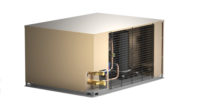With refrigerant leakage rates averaging 20-30% in commercial groceries, it is vital to take action to reduce costly waste. The earlier a leak is detected, the sooner it can be tackled and the less harm it causes to the environment and a user's bottom line. This deep dive into different leak detection methods and the expert systems dedicated to their continuous monitoring shows how.
The American Innovation and Manufacturing (AIM) Act, enacted in 2020, authorizes the U.S. Environmental Protection Agency (EPA) to address hydrofluorocarbons (HFCs) in three main ways: (1) phasing down their production and consumption, (2) promulgating certain regulations for purposes of maximizing reclamation and minimizing releases of HFCs from equipment and ensuring the safety of technicians and consumers, and (3) facilitating the transition to next-generation technologies through sector-based restrictions. This final rule focuses on the third area – the transition to substitutes through sector-based restrictions.
Because hydrofluorocarbons (HFCs) are potent greenhouse gasses, the regulatory landscape is quickly changing with new refrigerant regulations being created in New York, Washington, California and by the EPA. As many storeowners and operators are keenly aware, a 30% reduction (10% reduction in 2023) in the production and consumption of HFCs is mandated for 2024. This drop in availability may trigger expensive increases for refilling HFC refrigerant leaks, as seen in Europe’s conversion and the HCFC, CFC conversions in the U.S.
The new AIM rules are aligned with policy reports singling out Lifecycle Refrigeration Management as a primary method to reduce the impact of climate change, worldwide. The new regulations represent a major change for U.S. industry. A proposed rule focuses on the mandatory use of automatic leak detection as a pathway to reduce environmental impact. Many consultants advocate significant capital investments, including a major refrigeration equipment remodel, to use “natural” refrigerants. When it comes to effectively reducing overall use of HFCs, however, Matelex has found this truth to be self-evident: It doesn’t matter what type of refrigerant you use, so long as it stays in your system!
This is important for all companies.to understand, since many cannot afford the large capital expense to retrofit. The AIM act understands this and states under the heading Maintenance of Legacy Systems: “Allowing existing systems to continue to operate to the end of their useful life is important to ensuring a smooth transition in the phasedown of HFCs. A product or system may be serviced and repaired throughout its useful life; this includes replacing components, as needed.”
Automatic Indirect Detection vs. Automatic Direct Detection Methods
Indirect detection is defined by the U.S. government in the code of federal regulations, 40 CFR 82.157 (g)(4); “an indirect refrigerant detection system must automatically alert the owner or operator when measurements indicate a loss of 50 pounds of refrigerant or 10% of the full charge, whichever is less.” This definition defines compliance and is recognized as the generally accepted definition.
Direct detection can only be used to monitor components located inside an enclosed building or structure. Automatic direct detection has sensors or intakes placed so that they will continuously monitor the refrigerant concentrations in air in proximity to the walk-in box, compressor room, case and other areas with a high potential for a refrigerant leak. They must accurately detect a concentration level of 10 parts per million of refrigerant and alert the owner or operator when a refrigerant concentration of 100 parts per million of vapor of the refrigerant in the system.
It is not either/or! Any alarm triggered by a leak detection system using indirect measurement methods, then requires the leak to be located using a direct method. The two methods are complementary.
Direct methods alone, however, are insufficient. System Inspections are employed on an ad-hoc basis according to periods defined by regulations (every 3 months, 6 months, etc.). The manual system inspections are not constant monitoring. If a leak occurs the day after a visit, it will not be detected until the next visit months later. Meanwhile, the facility will operate in a degraded manner. Keep in mind that an under loaded system consumes more energy - up to 20% more! If the situation becomes prolonged, it may even result in lost perishable products. Furthermore, automatic direct leak detection can only measure single locations in a refrigerant system (i.e. cannot monitor the entire system like indirect does). It is unable to monitor condensers, open-air compressors or other areas that are exposed to the air.
Using both methods working together may uncover multiple leaks at one time. Sometimes, a leak is identified and repaired and the system still indicates a drop in level. At that point, you know there is another leak that needs to be located and fixed.
Advantages of Adding an Indirect Method
The automatic indirect measurement method ensures constant monitoring of installations, moving away from just checking leaks periodically or with direct solutions. Instead, you can be alerted as soon as a leak occurs, so you can intervene as quickly as possible. This will avoid costly refrigerant leakage and replacement, additional equipment maintenance, or catastrophic loss from a shutdown.
By continuously analyzing several parameters, while connected to the Internet and a monitoring platform, the indirect method can be particularly effective for managing more than one facility remotely. As soon as a leak is detected, alerts are sent to the appropriate people, with an estimate of the leak's flow rate and advice for intervention. Centralized dashboards can help prioritize maintenance according to the severity of the leak and the type of alarm.
How the Internet of Things (IoT) Multiplies Benefits
The emergence of the Internet of Things (IoT) and the implementation of algorithms has seen the birth of an indirect leak detection method that can actually gain expertise over time. After a learning period, a leak detection algorithm determines the reference level for a specific system. Based on the refrigerant level in the liquid receiver (HP), this algorithm is then able to identify any drift from normal operation.
These expert systems are based on a simple principle: cold demand varies constantly. Large food retailers will see their cooling demand vary according to how busy the store is: high on Saturdays, for example, with windows constantly opening and closing, low on Mondays after the weekend rush. This method differentiates between "normal" operation of a system with a variable cooling demand, and abnormal operation with a drop in level due to a leak.
Detection sensitivity, low-level alarm thresholds, and time delay can be adjusted for more or less fine-grained analysis. Level curves can be accessed online, showing both a trend curve and the more detailed daily curve. Additional data can be shown via filters for:
- Reservoir liquid inlet temperature.
- Liquid tank outlet temperature.
- HP temperature.
- LP temperature.
- Outside temperature.
- Superheat.
- Discharge temperature.
Alarms appear on level curves, and refills can be declared on site, or remotely, for detailed refrigerant level monitoring. In the event of a leak, a simple one-day recalculation determines the new reference level. Detailed analysis of actual behavior and tools help analyze and monitor performance.
For owners and operators of small to medium-size, automatic indirect detection technology can reduce costly leaks, and, if the proposed rules of the AIM act are approved, be compliant. Installing an indirect detection method will be a cost-effective solution, no matter what refrigerant your system is carrying or whether you already have a method for direct detection in place. By adding indirect detection, your operations will be monitored consistently, catch leaks sooner, and be able to run smoother by replacing those 3 AM emergency calls with regular maintenance appointments scheduled at appropriate intervals.
Another bonus is that continuous monitoring makes it possible to view the quantities of fluids loaded into installations on a fleet-wide scale, without having to be on site. For long-distance commuters, chain store owners, and facility managers, such global visibility is extremely valuable in terms of the amount of time saved. If you are evaluating leak detection technology, it is important to note there are many types of leak detection and several different types of companies marketed as indirect systems, it is important to be educated on what the differences between the technologies and what is most effective for your business. One of the key elements to check is experience. How many locations are using the tool and how long has the company been doing it and what annual leakage rate have they attained?
An Impact Calculator to estimate the environmental and financial impact of refrigerant leaks is available on the Matelex website.




